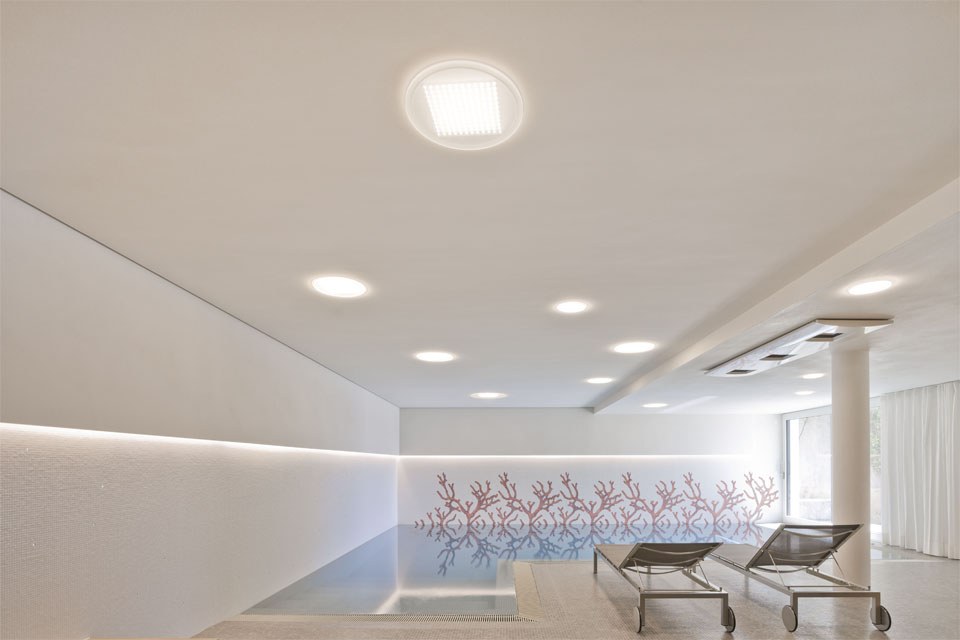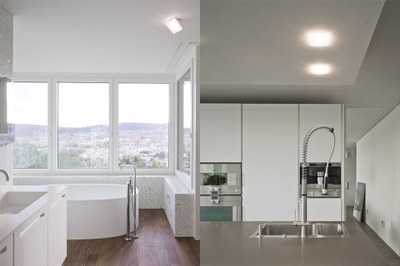Atmospheric Tension: LED Luminaires for Living Rooms, Spa Areas and Outdoors
LED luminaires and ingenious lighting design help create the right atmosphere in a new house on Stuttgart‘s slopes below the city‘s television tower. The LED lighting concept realized outside is maintained throughout the entire interior. According to Hans-Georg Popp, the building‘s architect, the interior pursues a theme which is „on the whole classical“.
Facts and Figures:
Location: Stuttgart; year built: 2010; around 600 square metres of living space;
architect: Hans-Georg Popp, Gerlingen;
lighting design: Hans-Peter Beutelspacher, Stuttgart;
LED luminaires: Nimbus Group, Stuttgart
As lighting designer Hans-Peter Beutelspacher explains: „By creating lighter and darker areas and wall surfaces, it was our intension to generate tension.“ The various lighting areas and varying atmosphere in this spacious house occupied by a family of five on the panoramic slopes surrounding Stuttgart are almost exclusively provided by light from LED luminaires. The clients were very open towards this innovative lighting technology, which is long established as far as lighting for offices and other non-residential buildings is concerned. And their openness was rewarded: together with the solar collectors, the combined heat and power pump and the controlled room ventilation system, the highly efficient LED luminaires help to keep energy costs very low in this family home, even though it covers almost 600 square metres of living space.
The house, which is split into four levels sitting on a slope, was not only fitted out with LED luminaires because of their energy-saving potential. It was a balance of aesthetic and practical considerations that led to the decision. „Unmistakable architecture and the use of natural materials,“ is how architect Hans-Georg Popp described the line he followed in the design. He did not follow the grey-white mainstream but instead went for a natural stone facade with shell limestone, warm-toned Cabreuva wooden flooring and wide, sharply defined spaces – „on the whole a classical approach“.
The Nimbus LED luminaires discretely blend in with their surroundings while catching the eye at the same time. For example, the ZEN IN recessed wall luminaires mounted at socket level (near floor level) wind their way through the various rooms like a thematic design element. They form the one central light source in the house – as motion-activated lighting. That is to say, as soon as dusk sets in, these luminaires switch themselves on (automatically via a building control system); when it becomes light in the morning, they go off again. Between 11:30 p.m. and 06:00 a.m. they are dimmed down to their basic lighting level. The occupants can then move around the whole house at night without having to use a light switch. This convenient solution in terms of lighting and safety is possible because of the luminaires‘ very low power consumption. For example, around 300 m2 on the ground floor can be lit with just 15 W.
Rotatable and tiltable Module Q 36 TT ceiling luminaires set lighting accents in the large living space in the form of dark or lighter vertical wall surfaces that create a special atmosphere and lend the room further depth.
The luminaires can be tilted and rotated to direct light at specific wall areas to create the perfect atmosphere and the perfect setting for the works of art which adorn the walls. The surrounding materials play a crucial role in influencing whether the light is perceived as being „cosy“. For example, the surfaces of the wooden floor and of the sand-coloured wall in this hillside house reflect the light in a warm tone. However, there is one thing which both the architect and the lighting designer advise against: using LED and conventional lighting in parallel. „The character of the light is too different.“ The few conventional lights that can be found in the house mainly serve as „decorative lighting“, as chandeliers or reading lamps.
Strictly regular or playfully irregular – anything is possible The motion-activated lighting in the interior has been carried over to the exterior – thus linking the two areas both optically and atmospherically. The ZEN ON Aqua outdoor luminaire was used for the exterior; this model is soon due to enter series production. With the clients being happy to experiment, space was also found for other special luminaires. The black Whisky Fox outdoor luminaire is a new, round version of the Whisky Pur outside luminaire.
The swimming pool presents a completely different picture. Lighting designer Hans-Peter Beutelspacher explains the concept thus: „The strictly regular look gives way to a more playfully irregular look.“ Instead of the linear arrangement of Q luminaires, which are normally arranged in groups of two or three, here we have irregularly positioned round Module R 144 luminaires which slightly deviate from the standard version: the idea to install them originated from Nimbus CEO Dietrich Brennenstuhl. The all-round cove lighting also produces a very special kind of light. This is a LED light strip housed in a ledge around the wall which illuminates a glass mosaic both above and below the surface of the water. Such cove lighting has also been used in the bathrooms and the visitors‘ lavatory with the effect that the walls seem to light up all by themselves.
Both the architect and the lighting designer are of the opinion that LED luminaires have a great future in the home. Hans-Peter Beutelspacher also sees a great benefit in the fact that LEDs require no maintenance and generate little heat.
At the end of the day, the new home owners are highly satisfied and happy with the result of their LED lighting. Any initial prejudices they may have had against LED lighting– e.g. the lighting effect is too cool – were dispelled by an experimental set-up at „Mock-Up“, Nimbus‘s own light laboratory. The warm atmosphere sought by the clients has been beautifully realized with LED light. As the client proudly declared: „Knowing that you have done the right thing both in terms of ecology and economy without compromising on lighting comfort is a very good feeling.“
About Nimbus Group:
The Nimbus Group employs a staff of 140 and is active around the globe as a premium vendor of lighting and acoustics solutions for private homes and non-residential premises. The Stuttgart enterprise maintains light and acoustic laboratories, so-called “Mock-Ups”, both in Europe and overseas. Around 10 years ago, founder Dietrich Brennenstuhl began to focus his attention on the future-oriented issues of energy-efficiency and LED lighting – and set up a qualified team of engineers, lighting experts and product developers; today the dynamic development department alone numbers fifteen employees. Interdisciplinary, out- of-the-box thinking is an integral part of the company’s concept: the Nimbus Group numbers various faculties from renowned universities, the Fraunhofer Institute for Building Physics as well as famous architects and the German Sustainable Building Council among its cooperation and innovation partners from the fields of science and research. In September 2010, the Nimbus Group was accepted as a foundation member of the German Design Council.





